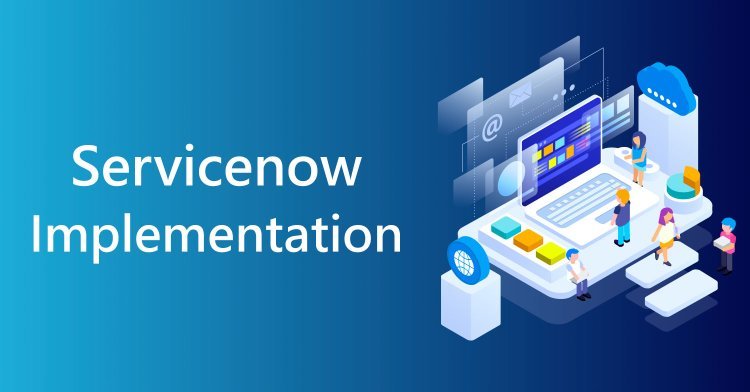Top Challenges in ServiceNow Implementation and How to Overcome Them

ServiceNow is a powerful platform designed to enhance productivity, streamline processes, and foster organizational efficiency. Despite its immense potential, implementing ServiceNow is not without challenges. Understanding these obstacles and their solutions is crucial to ensure a smooth implementation and long-term success.
1. Lack of Clear Objectives and Scope Definition
One of the most common challenges in ServiceNow implementation is the absence of well-defined objectives and scope. Without clarity on what the organization aims to achieve, projects often suffer from scope creep, delays, and dissatisfaction.
Solution:
- Conduct a thorough needs analysis to identify pain points and desired outcomes.
- Engage stakeholders from all relevant departments to gather comprehensive requirements.
- Create a clear project roadmap with defined goals, milestones, and deliverables.
- Use tools like ServiceNow’s Agile Development to manage and prioritize tasks effectively.
2. Inadequate Stakeholder Engagement
Resistance to change is a natural response, especially when stakeholders feel excluded from the decision-making process. Poor engagement can lead to limited adoption and suboptimal use of the platform.
Solution:
- Involve stakeholders early in the implementation process and keep them informed at every stage.
- Organize workshops, training sessions, and demonstrations to showcase the platform’s capabilities and benefits.
- Address concerns promptly and create a feedback loop to improve communication and collaboration.
3. Insufficient Training and Change Management
ServiceNow’s vast capabilities can overwhelm users if they are not adequately trained. A lack of change management strategies can further hinder adoption.
Solution:
- Develop a comprehensive training program tailored to different user roles.
- Use ServiceNow’s training modules, documentation, and community resources.
- Implement a change management plan that includes regular updates, training sessions, and support.
- Designate “champions” within departments to promote and support the platform’s use.
4. Data Migration Complexities
Migrating legacy data to ServiceNow can be a daunting task, particularly when dealing with disparate systems and inconsistent data formats.
Solution:
- Perform a data audit to identify and clean up outdated or irrelevant information.
- Use ServiceNow’s data migration tools and work with experienced professionals for complex migrations.
- Conduct data validation and testing to ensure accuracy and completeness post-migration.
- Establish data governance policies to maintain data integrity in the future.
5. Integration with Existing Systems
Integrating ServiceNow with other enterprise systems like ERP, CRM, and HR platforms can pose technical challenges.
Solution:
- Leverage ServiceNow’s IntegrationHub and APIs to connect with external systems seamlessly.
- Engage experienced developers or ServiceNow partners for complex integrations.
- Test integrations thoroughly to identify and resolve compatibility issues before full deployment.
- Maintain proper documentation for all integrations to simplify future updates or troubleshooting.
6. Customization Overload
Excessive customization can make the system difficult to maintain and upgrade, leading to higher costs and technical debt.
Solution:
- Prioritize configuration over customization to align with best practices and ensure system stability.
- Adopt ServiceNow’s out-of-the-box functionalities whenever possible.
- Implement a governance framework to assess and approve customization requests.
- Regularly review and optimize existing customizations to align with organizational needs.
7. Performance Issues
Poor system performance can significantly impact user satisfaction and productivity. Factors like excessive workflows, inefficient scripts, or large data volumes can contribute to performance degradation.
Solution:
- Conduct regular performance monitoring and optimization using ServiceNow’s Performance Analytics.
- Optimize workflows and scripts to reduce system load.
- Archive older records to manage data volume and improve response times.
- Collaborate with ServiceNow support or partners to address persistent performance issues.
8. Security and Compliance Concerns
Ensuring data security and compliance with industry regulations can be a challenge, particularly for organizations handling sensitive information.
Solution:
- Use ServiceNow’s robust security features, such as encryption, role-based access controls, and audit trails.
- Conduct regular security assessments and vulnerability scans.
- Stay updated on compliance requirements and leverage ServiceNow’s compliance management solutions to monitor and enforce policies.
- Train staff on best practices for data security and privacy.
9. Budget Overruns
Without proper planning, implementation costs can spiral out of control, affecting the project’s ROI.
Solution:
- Develop a detailed budget that accounts for licensing, implementation, training, and ongoing support costs.
- Monitor expenses closely and adjust plans as needed to stay within budget.
- Work with experienced ServiceNow partners to minimize unexpected costs.
- Conduct a cost-benefit analysis regularly to ensure alignment with business goals.
10. Limited Post-Implementation Support
A successful launch does not guarantee long-term success. Without adequate post-implementation support, the system’s potential may remain untapped.
Solution:
- Establish a dedicated support team to handle user queries and issues.
- Use ServiceNow’s Knowledge Management to create a repository of FAQs and guides.
- Schedule regular system health checks and updates to keep the platform optimized.
- Encourage a culture of continuous improvement by incorporating user feedback into system enhancements.
Conclusion
ServiceNow implementation presents challenges, but with careful planning, stakeholder engagement, and the right strategies, these obstacles can be effectively addressed. By focusing on clear objectives, robust training, seamless integration, and continuous support, organizations can unlock the full potential of ServiceNow and achieve their digital transformation goals.
What's Your Reaction?














